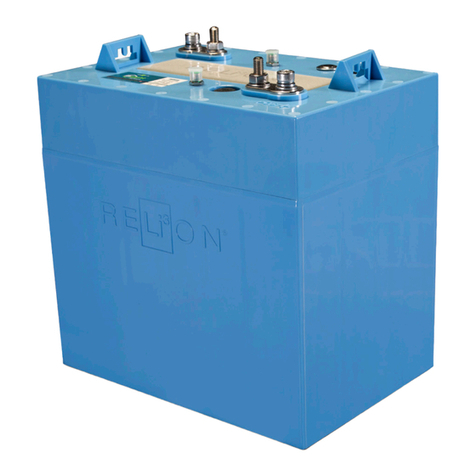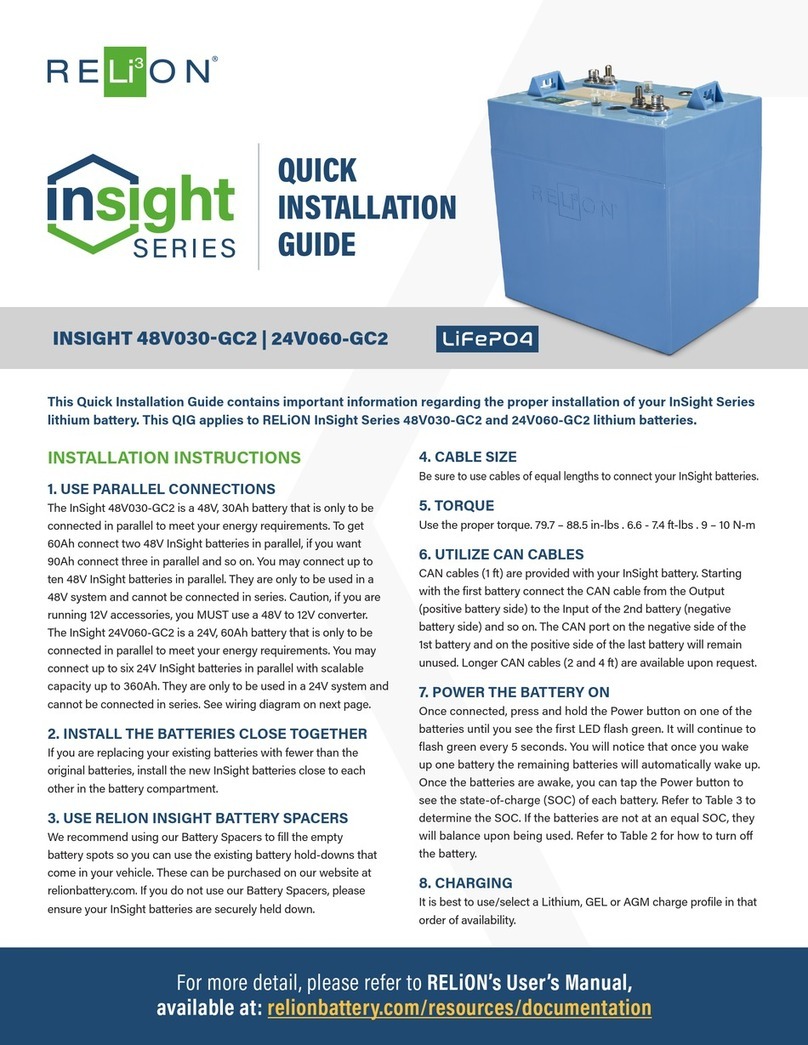
relionbattery.com +1.803.547.7288
844.385.9840
9868 Harrisburg Road
Fort Mill, SC 29707, US
© 2018 Relion Battery, LLC. All rights reserved. Relion Battery is not liable for damages that may result from any information provided in or omitted from this publication, under any circumstances. Relion Battery reserves the right to make adjustments to this publication at any time, without notice or obligation.
Installation & Operation Manual 06.13.18
7.2. Charging Temperature
Lithium Iron Phosphate batteries generate a fraction of the heat of other lithium chemistries making them very safe.
LiFePO4batteries can safely charge between -20°C to 55°C (-4°F to 131°F). However, at temperatures below 0°C (32°F)
the charge current must be reduced as follows:
1. 0°C to -10°C (32°F to 14°F) charge at 0.1C (10% of the battery capacity)
2. -10°C to -20°C (14°F to -4°F) charge at 0.05C (5% of the battery capacity)
LiFePO4batteries do not require temperature compensation for voltage when charging at hot or cold temperatures. All
RELiON LiFePO4come with a BMS that protects the battery from over-temperature. If the BMS disconnects due to high
temperature, wait until the temperature reduces and the BMS reconnects the battery circuit before using or charging the
battery. Please refer to your battery data sheet for BMS high temperature cut-o value.
7.3. Charging with Lead-Acid Chargers
Most lead-acid battery chargers can be used with LiFePO4batteries as long as they are within the appropriate voltage
guidelines. AGM and Gel algorithms typically fall within the LiFePO4voltage requirements. The voltage for flooded battery
charging algorithms are often higher than LiFePO4requirements which will result in the BMS disconnecting the battery
at the end of the charge cycle and may result in the charger displaying an error code. If this happens, it is generally a
good practice to replace your charger. Since the BMS protects the battery, using lead-acid chargers will not damage the
battery. Please refer to RELiON’s Lithium Charging Instruction document (available on our website at relionbattery.com)
for complete charging instructions and parameters.
8. BMS Operation
All RELiON LiFePO4batteries come with in internal or external BMS. The BMS protects against:
1. Under-Voltage – during discharge
2. Over-Voltage – during charge or regen conditions
3. Over-Current – during discharge and charge
4. Over-Temperature – during discharge or charge
5. Short-Circuit Protection – protects battery cells from damage
Refer to the data sheet for your battery's specific discharge criteria. If the BMS disconnects the battery due to voltage or current
limits, you must remove the load to reconnect the battery. If the BMS disconnects the battery due to temperature limits, you
must wait for the temperature to reduce to reconnect the battery. If your equipment has parasitic loads, it may require a physical
disconnect of the terminals to reconnect the battery circuit. Please note, that while short-circuit protection protects the battery's
cells, it still may produce a spark and damage your cable or bolt, so it is best to avoid short circuit conditions.
9. Battery Recycling
Terminals must be covered with a protective cap or non-conductive tape prior to battery disposal to lithium recycler.
Dispose of LiFePO4batteries at an authorize lithium recycling facility.
10. Technical Support
If you have technical questions about the Product, please contact the place of purchase or RELiON Battery directly at
803-547-7288 or our toll-free number 844-385-9840.
























